The Radeon HD 5970: Completing AMD's Takeover of the High End GPU Market
by Ryan Smith on November 18, 2009 12:00 AM EST- Posted in
- GPUs
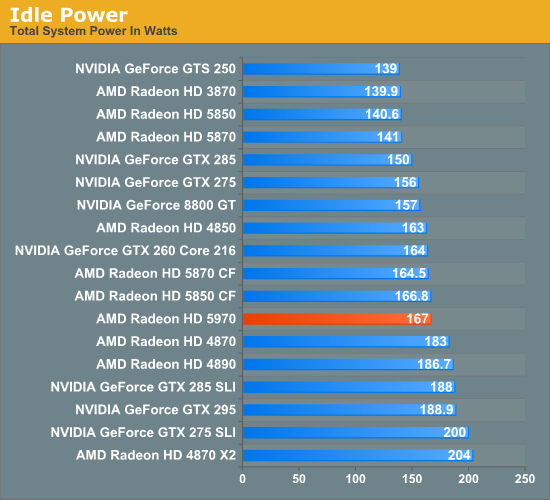
Thanks to AMD’s aggressive power optimizations, the idle power of the 5970 is rated for 42W. In practice this puts it within spitting distance of the 5800 series in Crossfire, and below a number of other cards including the GTX 295, 4870X2, and even the 4870 itself.
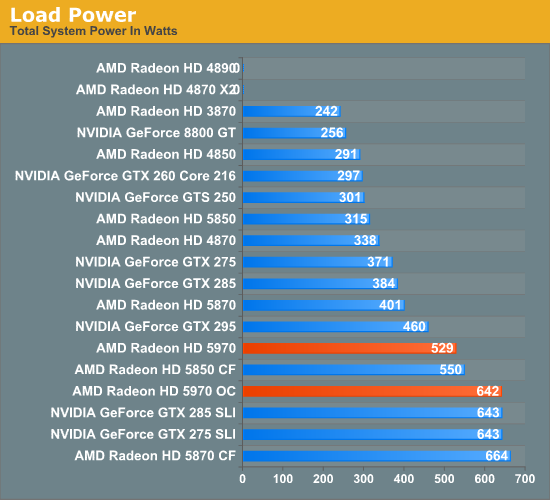
Once we start looking at load power, we find our interesting story. Remember that the 5970 is specifically built and binned in order to meet the 300W cap. As a result it offers 5850CF performance, but at 21W lower power usage, and the gap only increases as you move up the chart with more powerful cards in SLI/CF mode. The converse of this is that it flirts with the cap more than our GTX 295, and as a result comes in 69W higher. But since we’re using OCCT, any driver throttling needs to be taken in to consideration.
Looking at the 5970 when it’s overclocked, it becomes readily apparently why a good power supply is necessary. For that 15% increase in core speed and 20% increase in memory speed, we pay a penalty of 113W! This puts it in league with the GTX series in SLI, and the 5870CF, except that it’s drawing all of this power over half as many plugs. We’re only going to say this one more time: if you’re going to overclock the 5970, you must have a very good power supply.
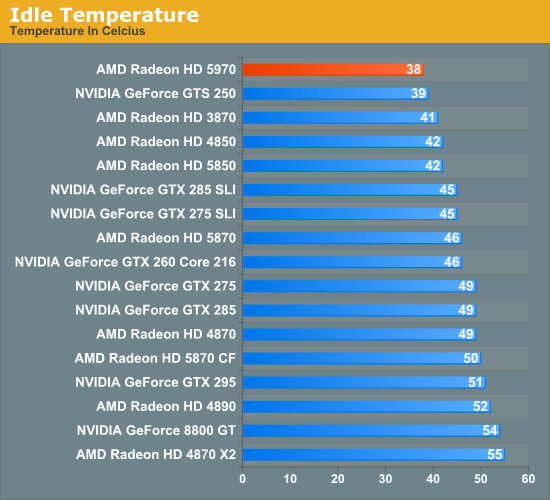
Moving on, the vapor chamber cooler makes itself felt in our temperature testing. The 5970 is the coolest high-end card we’ve tested (yes, you’ve read that right), coming in at 38C, below even the GTS 250. This is in stark opposition to previous dual-GPU cards, which have inhabited the top of the chart. Even the 5850 isn’t quite as cool as a 5970 at idle.
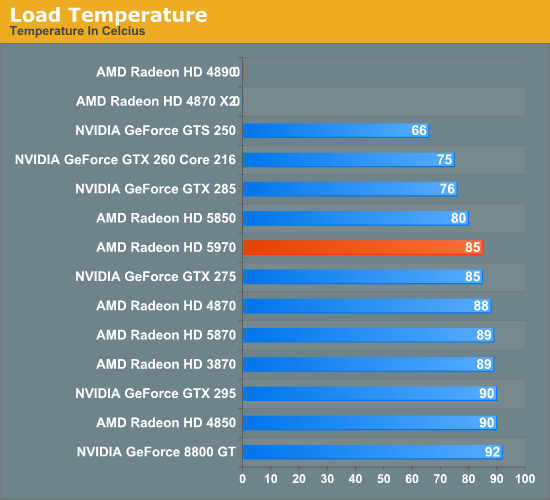
At load, we see a similar but slightly different story. It’s no longer the coolest card, losing out to the likes of the 5850 and GTX 285, but at 85C it hangs with the GTX 275, and below other single and dual-GPU cards such as the 5870 and GTX 295. This is a combination of the vapor cooler, and the fact that AMD slapped an oversized cooler on this card for overclocking purposes. Although Anand’s card failed at OCCT when overclocked, my own card hit 93C here, so assume that this cool advantage erodes under overclocking.
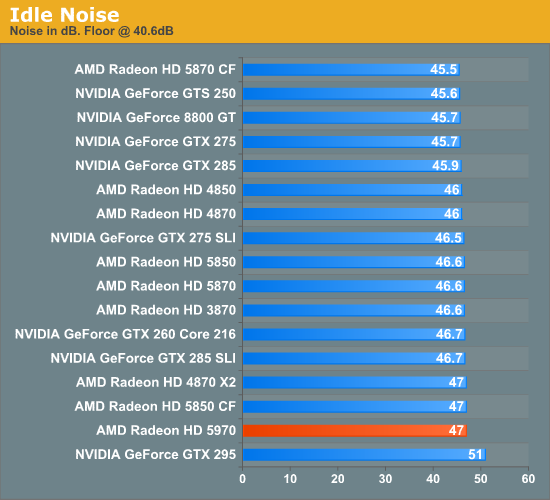
Finally we have our look at noise. Realistically, every card runs up against the noise floor, and the 5970 is no different. At 38C idle, it can keep its fan at very low speeds.
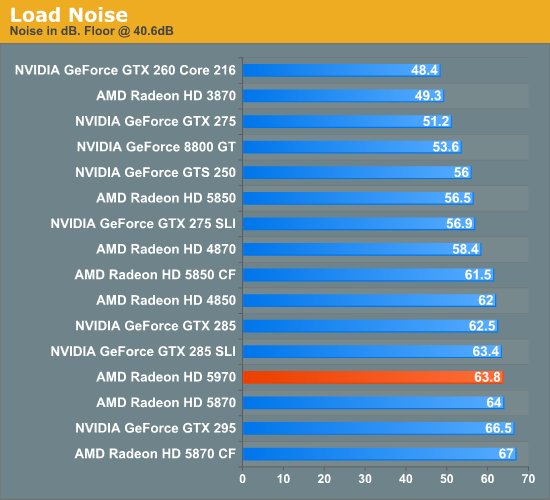
It’s at load that we find another interesting story. At 63.8dB it’s plenty loud, but it’s still quieter than either the GTX 295 or 5870CF, the former of which it is significantly faster than. Given the power numbers we saw earlier, we had been expecting something that registered as louder, so this was a pleasant surprise.
We will add that on a subjective basis, AMD seems to have done something to keep the whine down. The GTX 295 (and 4870X2) aren’t just loud, but they have a slight whine to them – the 5970 does not. This means that it’s not just a bit quieter to sound meters, but it really comes across that way to human ears too. But by the same token, I would consider the 5850CF to quieter still, more so than 2dB would imply.










114 Comments
View All Comments
Zool - Wednesday, November 18, 2009 - link
So yes. The answer is that the gpu is doing less work with vsync than without it.(dam still no edit button)Yojimbo - Wednesday, November 18, 2009 - link
The plural for a casting/shaping instrument "die" is "dies" not "dice."Lennie - Wednesday, November 18, 2009 - link
I am going to post this again here. Thought it may not get noticed since I posted it first as a reply in previous pages. Hope I wont hurt anyones feelings :)I thought everyone knew about Furmark and ATi by now. It used to be like this on 4870 series too.
It went like this, at first there were few reports of 4870(X2) cards dying when running Furmak. Further investigation showed that it was indeed Furmark causing VRM's to heat up to insane levels and eventually killing them. Word reached ATi from that point on ATi intentionally throttles their card when detecting Furmark to prevent the damage.
Yeah in fact the amount of heat load Furmak puts on VRMs is unrealistic and no game is able to heat up the VRMs to the level Furmark does. OCCT used the same method (or maybe even integrated Furmark) to test for stability (in their own opinion ofc)
So beware about Furmark and OCCT if you have HD4K or 5K.
The term "Hardware Virus" is rightfully applicable to Furmark when it comes to HD4K (and 5K perhaps)
Lennie - Wednesday, November 18, 2009 - link
I want to add that VRM overheating is quite tricky, since normally people only check on GPU temps.When you run Furmark you would notice that GPU temps are in acceptable range while at the same time your VRM's are cooking without you knowing about it.
So remember to always check your VRM temps when running graphics stability tests like Furmark or OCCT's graphics test specially when you're overclocking the card.
I use Riva or Everest to check on VRM temps.
Rajinder Gill - Thursday, November 19, 2009 - link
The temp reading that is displayed by Everest is an averaged figure. The junction temp of the slaves is the critical issue. Even though the average temp may appear to be within bounds, there is the possibility that one of the slaves may be running abnormally. Volterra keep their specifications under NDA. What I do know is that the general configuration if one slave shuts down is that the remaining slaves take the load. The result is not usually pretty. I think ATI may have implemented throttling to prevent the kind of burnouts users experienced running OCCT GPU tests on the last gen.Personally, I think the 3 phase Volterra solution used on the 5970's is right on the hilt for current draw (circa 135 amps per GPU). I'd wait for non reference solutions with enhanced power delivery if you plan on overclocking this card long term or plan to stress it heavily when OC'd).
Later
Raja
Rajinder Gill - Thursday, November 19, 2009 - link
I should add that I'm assuming ATI used the biggest Volterra slaves rated at 45 amps each and not the 35/40 amp varieties.thebeastie - Wednesday, November 18, 2009 - link
Any one that has a clue is buying a proper case like the Storm Sniper Black Edition and fitting this with heaps of space to spare.Also I recommend a case with positive or at least neutral are flow.
The storm sniper has a dust filter on its 20cm side fan to push more air in and aid in the GPU fans air flow that will go out the back of the cards vent holes at the DVI ports.
at80eighty - Wednesday, November 18, 2009 - link
Plan on getting one of these in another 7-8 months - The way I see it, despite being bleeding edge - ATI has a deadlock winner in this card and will produce only limited quantities so I'm kind of 'worried' about the availability & price down the lineSilverforce11 - Wednesday, November 18, 2009 - link
Wait til the end of December. Apparently the yeilds of cyrpress are going to be improved a lot then, so the prices will either remain the same or be lower a bit.However, since nV has nothing real for a long time, i dont foresee a drop in prices on ATI parts. Given the estimates, NV will have fermi out in april 2010, but not in significant quantities for a while after that. Im gonna grab a 5970 around xmas. :)
at80eighty - Wednesday, November 18, 2009 - link
Dude I hate you already :p I just bought a 5750 - I dont have the necessary components that would not bottleneck the 5970, so I'm going to have to wait a while. plus the whole 3 new monitors thing for the Eyefinity